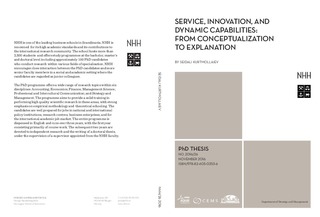| dc.description.abstract | The overall purpose of this dissertation is to investigate the role of dynamic capabilities in
service innovation. However, I do not accept the notions of service innovation and dynamic
capabilities as given, but instead I start with exploring their meanings. Next, due to the lack of
an adequate instrument for measuring dynamic capabilities, I operationalize sensing, seizing,
and transforming capabilities. Finally, I investigate how managerial dynamic capabilities can
be developed and how they affect innovation and operational capability in a service
organization. Thus, my research questions are as follows: 1) What is service innovation? 2)
What are dynamic capabilities? 3) How can dynamic capabilities be operationalized? 4) How
can dynamic capabilities be developed, and how do they affect service innovation and
operational capability? I answer each question in a series of four articles.
In Article 1, I demonstrate that service innovation is neither a well-established concept
nor a commonly understood phenomenon. Instead, I outline six existing perspectives on what
service and service innovation are: new service development (NSD), service engineering,
service infusion, service design, service reconfiguration, and service integration. Each of these
perspectives has its own research focus, logic, and vocabulary, but the NSD perspective
creates a strong gravitational field that decelerates the real advancement of other perspectives.
Moreover, NSD itself is under the influence of new product development research. As a
result, perspectives suffer from lexical cross-contamination and parallelism in approaches that
obstruct researchers from making novel and relevant contributions. To overcome these
challenges, I encourage a more distinct pluralism of perspectives while not excluding the
possibility of meaningful conversations across them.
In Articles 2, 3, and 4, I take the NSD perspective, but I do so in an unconventional
manner. I examine dynamic capabilities—a factor that, at least in theory, influences the
success of changes in the bundle of the organization’s services, the latter defined as the
organization’s core activities.
In Article 2, I critically assess dynamic capabilities as a notion, concluding that the
current interpretations of the term are unsustainable and unsatisfactory. I suggest a new
definition of dynamic capabilities that specifies necessary and sufficient conditions for
dynamic capabilities: the individual’s intention to change the status quo in the organization as
well as the individual’s high level of influence in the organization. I further outline possible
antecedents and outcomes of dynamic capabilities.
In Article 3, I apply the original tripartite disaggregation of dynamic capabilities to
managers. I clarify the notions of managerial sensing, seizing, and transforming capabilities
by delineating what they are and what they are not. I then develop and empirically validate a
brief measure of managerial sensing, seizing, and transforming capabilities. Using structural
equation modeling, I provide evidence that transforming is dependent on seizing, and in turn,
that seizing is dependent on sensing. Moreover, I demonstrate that managerial seizing
capability is positively related to innovation, while managerial transforming capability is
positively related to cost reduction.
In Article 4, I theorize that training team leaders in design thinking principles and tools
leads to the development of their managerial sensing, seizing, and transforming capabilities,
which then influences their teams’ innovation and operational capability. Testing the model
relies on a quasi-experimental field study with a control group and a four-month time lag. The
intervention is presented randomly over time in six geographically isolated business units of a
large multinational telecommunications company. The results show that the training program
has a positive effect on the participants’ managerial sensing and seizing capabilities, which
have a positive effect on managerial transforming capability, the teams’ innovation, and the
teams’ operational capability. These positive effects are paralleled by a direct negative effect
of the program on the operational capability of the participants’ teams. In addition, the effect
of managerial transforming capability on the teams’ operational capability is non-significant.
In this summary, I provide a general overview of the theoretical and methodological
choices I made while working on my dissertation. I also present the key results, discuss
implications and limitations of this work, and suggest future research opportunities. | nb_NO |
